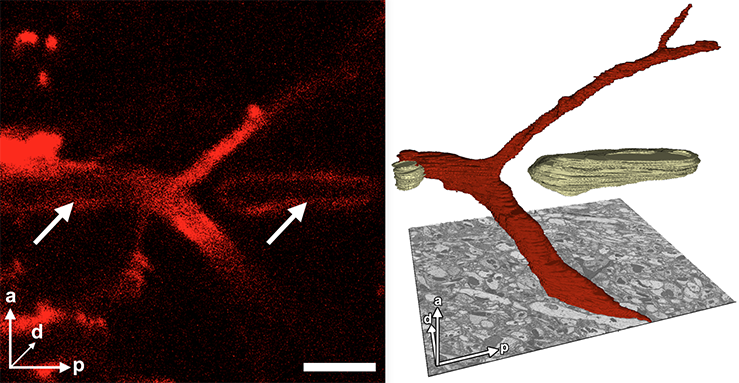Microscopy is an essential tool in life science research. Within VIB, this expertise is centralized in two core facilities: the BioImaging Core (BIC), with labs in both Leuven and Ghent. Each has their own specialization. The Ghent BIC is at the forefront of an effort to develop a methodology that combines the power of light and electron microscopy to generate three-dimensional images that provide a wealth of information.
CLEM > EM + LM
“Combining different types of information like this is the future,” Saskia Lippens, Manager of the Imaging Core in Ghent, says. “There is a synergistic effect in bringing this information together. Light microscopy gives you a high-level overview of your sample, where functional – often fluorescent – probes light up events of interest. With electron microscopy, we can then zoom in on these areas at the nanoscale and obtain high-resolution images that provide a lot of context and help us to understand what’s going on inside the cell. In that sense, it’s like finding a building where the light is on from a satellite image, and then being able to go inside and see the people working there.”
The methodology the BIC uses is called CLEM, which stands for correlative light electron microscopy. BIC Ghent uses an innovative technique called volume electron microscopy to create the three-dimensional images. “This is one of our focus points,” Lippens says. “It is important, because biological processes and structures are three-dimensional by nature.” The electron microscopy images are created with a slice and view technique, where an image is taken and a layer of the sample is then removed mechanically or with an ion beam. Finally, the individual images are combined to a three-dimensional view.
Implementation, application and development
One of the challenges faced with this technique is the interpretation of the massive amounts of data that are generated. In electron microscopy every detail of the sample is revealed and it is then time consuming to visualize specific objects from the comprehensive view that is generated. Tracing individual structures like organelles is performed in a process called segmentation. In light microscopy, this is easily achieved because light has differences in colour and intensity. No such straightforward parameters are available in the grey-scale electron microscopy images. Together with the Imaging Processing and Interpretation group of Ghent University (IPI), the BioImaging Core is developing an computer algorithm for the automatic segmentation of electron microscopy data.
It is clear that the Imaging Core does more than merely implement a state-of-the-art methodology developed elsewhere. While CLEM was typically applied in brain tissue imaging, the VIB’s needs were much broader. “At VIB, the model organisms used range from bacteria and yeasts, to plant material or even mice,” Lippens says. “We have developed protocols to expand the applicability of CLEM.” This puts the BIC at the forefront of the field. “The CLEM community is quite small because of the significant investment it requires to be able to obtain these kinds of images,” Lippens explains. “There are many prominent life sciences institutes that still lack this capability, while we have been working on it for 5 years already.”
Smart investments
The Ghent BIC was founded in 2012 by VIB Senior Scientist Chris Guérin, and supported by Flemish government funding. While Saskia Lippens manages the Ghent department, the Leuven counterpart is led by Sebastian Munck. Founding a core facility to harbour the microscopy facilities was an excellent strategy. “This centralisation allows the expensive equipment to be used efficiently and prevents overlapping investments in the same organisation,” Lippens clarifies. “But even more important is that it ensures the presence of highly skilled personnel who apply their life science expertise in mentoring interested researchers. We are more than an imaging service as we provide extensive consultancy from experimental design to data processing and interpretation.”
BIC’s services are not limited to VIB researchers, even groups from international institutes recognize its expertise. Recent collaborations include the Max Planck Institute, the University of Bordeaux and US-based academic research groups as well as industrial clients. The BIC provides a rare and valuable research to all scientists when they need the unique insights CLEM offers.


